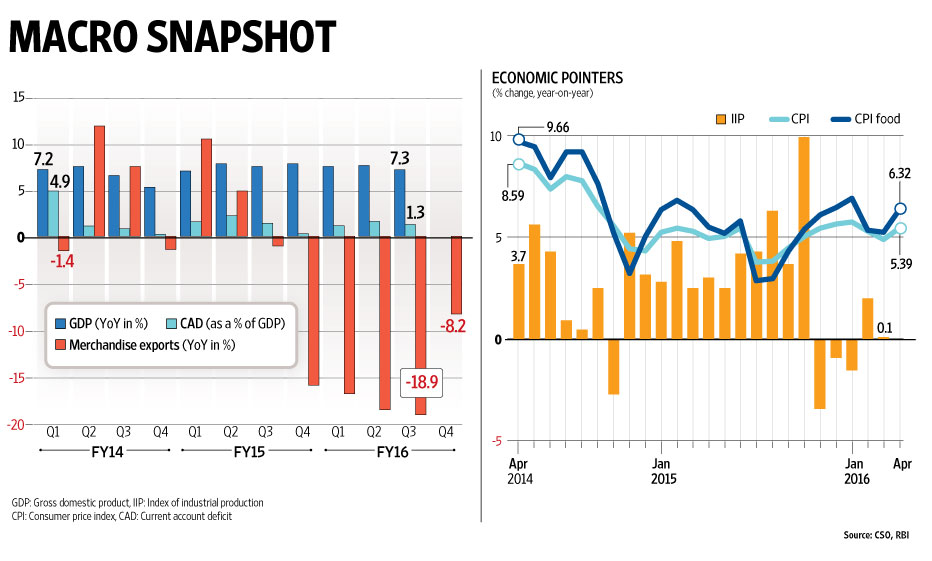NDA in the right direction, but still a long way to go
Volatile growth in factory output, sluggish rural demand among causes for concern

New Delhi: The International Monetary Fund has termed the Indian economy a “bright spot” in the otherwise bleak global economy with the country remaining the fastest growing major economy for the second consecutive year outpacing a slowing Chinese economy, much to the satisfaction of the Narendra Modi government.
With an economy that is projected to have clocked 7.6% growth in 2015-16, retail inflation within the comfort level of the central bank, current account deficit at 1.3% of gross domestic product (GDP) in the December quarter and foreign direct investment growing at 40% during the April-December period, the government is likely to be quite pleased. The low crude oil price has come as a boon for the Indian economy, helping the Modi government set petroleum prices free of government control and reduce its subsidy burden. The government has used this additional fund available in building infrastructure through higher public investment in sectors such as road and railways.
However, all is not well with the economy. Merchandise exports have contracted for the 17th consecutive month, growth in factory output remains volatile, private investment is yet to pick up and rural demand remains sluggish owing to two consecutive monsoon failures. The drought situation which has affected 330 million people in 266 districts of 11 states has further increased the woes of the government.
D.K. Srivastava, chief policy adviser at consulting firm EY India, said it’s a mixed picture when it comes to economic governance in the past two years under the Modi government. “Most policy initiatives taken by the government are in the supply side such as ‘Make In India’ and smart cities programme while the main problem is deficient domestic and global demand. It could not do much in stimulating domestic demand due to its fixation with the fiscal deficit target.”
Finance minister Arun Jaitley stuck to his fiscal consolidation roadmap for 2016-17 with the fiscal deficit target of 3.5% of GDP, despite demands from some quarters advocating fiscal expansion to stimulate economic growth. However, Srivastava said the committee to revise the fiscal consolidation roadmap set up under former secretary in the finance ministry N.K. Singh may provide the government much-needed flexibility to allocate higher public investment when demand in the economy is weak.
But rising crude oil prices have emerged as a new potential risk, though they are expected to not hit previous highs of above $100 per barrel. The World Bank has recently revised its average crude oil price forecast for 2016 to $41 per barrel from its earlier projection of $37 per barrel. The Indian basket of international crude oil price touched $45.5 per barrel on 19 May. Crude rebounded from a low of $25 per barrel in mid-January to $40 per barrel in April following production disruptions in Iraq and Nigeria and a fall in non-Organization of the Petroleum Exporting Countries (non-OPEC) production, mainly US shale.
“We are a little more sanguine about crude oil price because every forecast we have seen tells us that oil will remain below $60-70 per barrel. As long as it remains in that range, we are relatively in good shape,” minister of state for finance Jayant Sinha said in an interview.
While the Economic Survey has projected the economy to grow within a wide band of 7-7.75% in 2016-17, boosted by normal monsoon projection by the Indian Meteorological Department, finance minister Arun Jaitley has expressed hopes of the economy growing over 8% in the year.
However, the Survey has cautioned that with the global slowdown likely to persist, chances of India’s growth rate in 2016-17 increasing significantly beyond 2015-16 levels are not very high. “The wider range in the forecast this time reflects the range of possibilities for exogenous developments, from a rebound in agriculture to a full-fledged international crisis; it also reflects uncertainty arising from the divergence between growth in nominal and real aggregates of economic activity,” it said.
With tepid external demand failing to provide a boost to the economy, domestic demand has also not picked up. However, the implementation of the 6th Pay Commission report, which has provided a bounty to the 4.8 million central government employees and 5.5 million pensioners waiting for an approval from a committee of secretaries could provide a boost to domestic demand for consumer goods.
A key area where the government has lagged behind is in creating enough jobs for about 1 million youth entering the workforce every month. The latest Labour Bureau survey found that job creation in eight key sectors dropped to a seven-year low at 135,000 in 2015. While the government has launched ambitious programmes like Make In India and Startup India focusing on generating manufacturing jobs and encouraging job creators rather than job seekers respectively, its impact on the ground has rather been slow.
But many mobile phone makers such as Lenovo Group Ltd, Flextronics International Ltd, Xiaomi Corp. and Foxconn Technology Group have already started production or are in the process of setting shop in India, leading to hope that the sector may turn a corner in coming days.
Srivastava said though the policy measures taken by the centre are in the right direction, interlinkage among various policy measures seems to be lacking. “There is no single strategic document like the Plan document (under previous governments) which clearly elucidates the linkage between various government programmes and notes down the sequence for each to be followed.”


No comments:
Post a Comment